Navigating the digital world means crossing paths with cookie consent messages almost daily. But when it's your turn to craft one for your website, where do you start? It's not just about legal compliance; it's about maintaining a positive user experience.
Crafting the perfect cookie consent message is a fine balance between clarity and conciseness. You want to inform your users without overwhelming them. Let's dive into how you can achieve this, ensuring your website stays on the right side of regulations while keeping your visitors happy and informed.
Understanding Cookie Consent Messages
Navigating the digital landscape means understanding the nuts and bolts of cookie consent messages. These notifications are not just simple pop-ups on a website; they're a crucial aspect of online privacy and compliance. Privacy laws like GDPR in Europe and CCPA in California have raised the bar for how websites must handle user data, making these messages more than just a formality.
When you land on a website, the cookie consent message is often the first thing you encounter. Its main purpose is to inform you about the site's use of cookies and, in some cases, to ask for your permission. This isn't just about legal compliance; it's also about building trust with you, the user. A well-crafted message will ensure you feel informed and in control of your online experience.
Key Components of a Cookie Consent Message
Every effective cookie consent message shares a few key elements:
- Clarity: The message should be easy to understand, avoiding technical jargon.
- Conciseness: Information overload can overwhelm, so it's important to keep it brief.
- Choice: Offering options such as accepting all cookies, rejecting non-essential cookies, or learning more about your cookie policy.
- Visibility: It should be prominently positioned so you can't miss it.
Remember, the goal is to strike a balance. You want to stay on the right side of the law and respect user privacy, but you also don't want to scare visitors away with overly complex consent requirements. Crafting a message that clearly explains what cookies are used for and how users can control their settings can significantly enhance user satisfaction and ensure legal compliance.
By incorporating these components into your cookie consent message, you'll not only adhere to privacy regulations but also foster a transparent and trusting relationship with your users.
Importance of Crafting a Clear Message

Crafting a clear cookie consent message isn't just about ticking a regulatory compliance box. It's fundamental to forging a transparent relationship with your users. When you deliver a message that's easy to understand, you align your website's values with the expectations of its visitors.
Visibility is key. Your message should stand out without disrupting the user experience. This means choosing the right spot on your page and ensuring the message is eye-catching yet not intrusive. Remember, the goal is to inform, not to overwhelm.
Another critical aspect is simplicity. Jargon-loaded sentences might meet legal standards, but they don't do much for user comprehension. Strive for straightforward language that conveys the purpose and use of cookies on your site. Here's the golden rule: if someone unfamiliar with digital privacy laws can't understand your message, it's probably too complex.
Choice plays a significant role in crafting your message. Offering users the ability to accept, reject, or customize their cookie preferences empowers them. It shows you value their privacy and are willing to accommodate their comfort levels. Plus, it encourages engagement by involving them in the decision-making process regarding their personal data.
Moreover, clarity in your cookie consent message builds trust. In an era where digital privacy is a hot topic, showing users you take their privacy seriously can set you apart. Trust is a cornerstone of any successful online relationship. By clearly communicating how you use cookies and what benefits they offer, you're laying the foundation for a trustworthy interaction.
Crafting a clear message is not just about compliance; it's about enhancing user experience, building trust, and establishing a transparent dialogue with your visitors. Taking the time to get this aspect right pays off in stronger user relationships and greater respect for user privacy.
Elements of an Effective Cookie Consent Message

When designing your website's cookie consent message, clarity and comprehension are key. The language you choose should be straightforward, devoid of jargon, making it accessible to all users regardless of their technical understanding. A clear message ensures users are fully informed about what they're consenting to.
Your message must highlight three critical choices: accept, reject, or customize settings. This degree of control respects user privacy and reinforces trust. It's not just about compliance with privacy laws; it's about valuing your visitors' preferences and privacy.
Visibility plays a crucial role in effective cookie consent messages. It shouldn't be hidden away in a corner but displayed prominently without being intrusive to the user experience. Consider using a design that complements your website but stands out enough to get noticed.
The importance of simplicity cannot be overstated. Users should not be overwhelmed with information but should receive enough detail to make an informed choice. A balance must be struck between transparency and brevity.
Remember, your cookie consent message is more than a legal requirement; it's a touchpoint for building a transparent and trusting relationship with your visitors. Incorporating these elements effectively will not only ensure compliance but also enhance the overall user experience on your website.
Strategies for Enhancing User Experience

When crafting a cookie consent message, your ultimate goal is to enhance the user experience on your website. This doesn't just mean making the message clear and compliant; it's also about how the message is integrated into the user journey. Here are some key strategies to ensure that your cookie consent message contributes positively to user experience.
Customization and Control: Give users the power of choice. Instead of a simple "Accept" button, include options to accept, reject, or customize according to their preferences. This not only shows respect for user privacy but also gives them control over their browsing experience.
Timing and Placement: The timing and placement of your cookie consent message can significantly affect user engagement. Avoid interrupting the user immediately upon site entry. Instead, allow them a moment to engage with your content. Place the consent message in a position that is easily visible without overshadowing the main content. Sidebar or bottom screen placements are often preferable.
Simplicity and Clarity: Keep the language simple and the design minimalistic. Users often skim through content, so ensuring your message is understandable at a glance is crucial. Highlight key information such as what cookies are used for and how users can change their settings later.
Testing and Optimization: Regularly test different versions of your cookie consent message. A/B testing can help determine which versions achieve better engagement and compliance rates. Pay attention to metrics like bounce rates and consent rates to gauge user response.
By implementing these strategies, you're not just complying with regulations; you're also prioritizing the comfort and privacy of your users. This approach fosters trust and encourages a more engaged and informed user base, ultimately contributing to a healthier relationship between your website and its visitors.
Crafting Your Own Cookie Consent Message

Creating a cookie consent message that aligns with your brand while keeping user experience at the forefront can seem daunting. However, it's crucial for establishing trust and ensuring your website complies with global privacy regulations. Here's how you can craft an effective cookie consent message.
First, start with clarity. Your message should straightforwardly explain the use of cookies on your site. Avoid jargon or technical terms that could confuse your users. The goal is to make sure that everyone, regardless of their technical expertise, understands what consenting means.
Incorporate a friendly and inviting tone. Remember, this message is often the first interaction someone has with your website. Using a tone that's overly formal or intimidating can turn visitors away. Instead, opt for friendly language that invites users into your digital space.
Offer clear choices. Users should be able to easily consent to cookies, reject them, or customize their preferences. This not only empowers your users but also demonstrates your commitment to their privacy. Including a direct link to your privacy policy within the message is also a best practice, providing an extra layer of transparency.
Highlight the benefits of accepting cookies. Briefly explain how cookies enhance the user experience on your site, such as by remembering login details or personalizing content. Users are more likely to consent when they understand the value exchange.
Ensure your message is visually engaging. The design should be consistent with your website's branding but still noticeable enough that users don't accidentally overlook it. Strategic use of color, typography, and placement can greatly influence the effectiveness of your cookie consent message.
Finally, test and optimize your message. Different audiences may respond better to different wording, styles, or placement of the consent message. Use A/B testing to find what works best for your site and audience, continually refining your approach based on user feedback and interaction data.
Conclusion
Crafting your cookie consent message doesn't have to be a daunting task. By focusing on clarity, a friendly tone, and providing clear choices, you're not just complying with regulations—you're also enhancing the user experience on your site. Remember, the key is to align the message with your brand while making it visually appealing and easy for users to understand. Testing and optimizing based on user feedback will further ensure your message resonates well and builds trust with your visitors. With the right approach, your cookie consent message can become a seamless part of your site's journey, fostering a transparent relationship with your audience.












